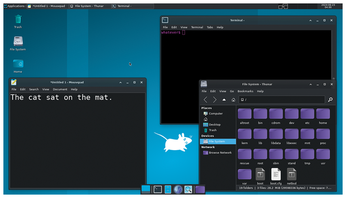Adventures in NetBSD
On the Metal
There's still an undeserved sense that BSD competency is something arcane and alchemic, but just as with Arch Linux or any other "niche" operating system, Google prompt-engineering and remaining alert will get you a long way.
In this article I'm going to run through installing NetBSD and the xfce4 desktop (Figure 1) on an old, repurposed laptop. The sacrificial machine for me was a ThinkPad T450, which I picked up refurbished on Amazon for £140 (~$180). This model came out in 2015. Older ThinkPads are generally a good choice for BSD compatibility. Additionally, a refurbished ThinkPad will be an order of magnitude more performant than a typical entry-level netbook, which pretty much becomes e-waste the moment it leaves the factory. The T450 I bought came with an Intel Core i5-5300U 2.3GHz CPU, 8GB of RAM, and a 256GB SATA hard drive.
It's hoped that once this tutorial has got you up and running with NetBSD, you can Google your way to the freedom-respecting OS of your dreams. I haven't covered everything a desktop user might desire (for example, you will need to research codecs if you want to play back YouTube videos at any reasonable framerate) – but you will have in your hands a really capable bare-bones system.
[...]
Buy this article as PDF
(incl. VAT)
Buy Linux Magazine
Subscribe to our Linux Newsletters
Find Linux and Open Source Jobs
Subscribe to our ADMIN Newsletters
Support Our Work
Linux Magazine content is made possible with support from readers like you. Please consider contributing when you’ve found an article to be beneficial.

News
-
Two New Distros Adopt Enlightenment
MX Moksha and AV Linux 25 join ranks with Bodhi Linux and embrace the Enlightenment desktop.
-
Solus Linux 4.8 Removes Python 2
Solus Linux 4.8 has been released with the latest Linux kernel, updated desktops, and a key removal.
-
Zorin OS 18 Hits over a Million Downloads
If you doubt Linux isn't gaining popularity, you only have to look at Zorin OS's download numbers.
-
TUXEDO Computers Scraps Snapdragon X1E-Based Laptop
Due to issues with a Snapdragon CPU, TUXEDO Computers has cancelled its plans to release a laptop based on this elite hardware.
-
Debian Unleashes Debian Libre Live
Debian Libre Live keeps your machine free of proprietary software.
-
Valve Announces Pending Release of Steam Machine
Shout it to the heavens: Steam Machine, powered by Linux, is set to arrive in 2026.
-
Happy Birthday, ADMIN Magazine!
ADMIN is celebrating its 15th anniversary with issue #90.
-
Another Linux Malware Discovered
Russian hackers use Hyper-V to hide malware within Linux virtual machines.
-
TUXEDO Computers Announces a New InfinityBook
TUXEDO Computers is at it again with a new InfinityBook that will meet your professional and gaming needs.
-
SUSE Dives into the Agentic AI Pool
SUSE becomes the first open source company to adopt agentic AI with SUSE Enterprise Linux 16.


